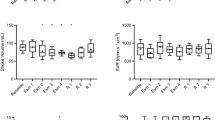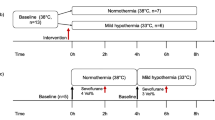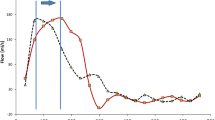Summary
To examine the effects of severe burns on preload and left ventricular (LV) contractility, we continuously measured LV pressures and dimensions in severely burned dogs throughout the early part of the postburn period. Hemodynamic parameters, including cardiac output (CO), mean aortic pressure (MAP), heart rate (HR), LV pressures and their first derivatives (dP/dt), and the LV regional dimension, were measured and compared before and every 30 min after burns were produced (up to 360 min) in four groups: group A (n=7), dogs with sham burns; group B (n=5), dogs with nonresuscitated full-thickness burns involving 50% of the total body surface area; group C (n=6), dogs with burns resuscitated with lactated Ringer's solution at 4 ml × kg × % burn/24 h; and group D (n=6), dogs with burns resuscitated with 1.5% dextran in lactated Ringer's solution at 2 ml × kg × % burn/24 h. From these measurements, we obtained the LV end-diastolic segment length (EDL) as an index of preload and three indices of cardiac contractility, i.e., peak dP/dt, the percentage of shortening (%ΔL), and mean Vcf. Our results showed that CO, MAP, and preload (i.e., EDL) decreased significantly more in the three burn groups (groups B, C, and D) than in the sham burn group, but that there were no significant differences in CO, MAP, and EDL among the three burn groups. The three indices of contractility also decreased significantly more in the three burn groups than in the sham burn group. When changes in LV end-diastolic pressure (LVEDP) and EDL during the experiment were examined, apparent discrepancies were found in the changes between LVEDP and EDL in the burn-resuscitated groups (C and D); the postburn decreases in LVEDP in the burn-resuscitated groups were significantly smaller than those in the burn-nonresuscitated group, but there were no significant differences in the postburn decreases in EDL among the three burn groups. These findings indicate that: (1) the fall in cardiac output following severe burns was due to both the decreased preload and decreased LV contractility; (2) the decreased preload and LV contractility could not be restored to preburn levels by conventional fluid therapy during the 6-h experimental period; and (3) the possible decrease in LV compliance was more prominent in the burn-resuscitated groups.
Similar content being viewed by others
References
Gilmore JP, Handford SW (1956) Hemodynamic response of the dog to thermal radiation. J Appl Physiol 8: 393–398
Dobson EL, Warner GF (1957) Factors concerned in the early stages of thermal shock. Circ Res 5: 69–74
Moncrief JA (1966) Effect of various fluid regimens and pharmacologic agents on the circulatory hemodynamics of the immediate postburn period. Ann Surg 164: 723–752
Cope O, Moore FD (1944) A study of capillary permeability in experimental burns and burn shock using radioactive dyes in blood and lymph. J Clin Invest 23: 241–257
Arturson G (1961) Capillary permeability in burned and nonburned areas in dogs. Acta Chir Scand (Suppl) 274: 55–103
Goodwin CW, Dorethy J, Lam V, Pruitt BA Jr (1983) Randomized trial of efficacy of crystalloid and colloid resuscitation on hemodynamic response and lung water following thermal injury. Ann Surg 197: 520–531
Adams HR, Baxter CR, Izenberg SD (1984) Decreased contractility and compliance of the left ventricle as complications of thermal trauma. Am Heart J 108: 1477–1487
Raffa J, Trunkey DD (1978) Myocardial depression in acute thermal injury. J Trauma 18: 90–93
Merriam TW Jr (1962) Myocardial function following thermal injury. Circ Res 11: 669–673
Bugge-Asperheim B, Leraand S, Kiil F (1969) Local dimensional changes of the myocardium measured by ultrasonic technique. Scand J Clin Lab Invest 24: 361–371
Glower DD, Spratt JA, Snow ND, Kabas JS, Davis JW, Olsen CO, Tyson GS, Sabiston DC Jr, Rankin JS (1985) Linearity of the Frank-Starling relationship in the intact heart: the concept of preload recruitable stroke work. Circulation 71: 994–1009
Badke FR (1982) Left ventricular dimensions and function during right ventricular pressure overload. Am J Physiol 242: 611–618
Sasayama S, Franklin D, Ross J Jr, Kemper WS, McKown D (1976) Dynamic changes in left ventricular wall thickness and their use in analyzing cardiac function in the conscious dog. Am J Cardiol 38: 870–879
Wallenstein S, Zucker CL, Fleiss JL (1980) Some statistical methods useful in circulation research. Circ Res 47: 1–9
Ilebekk A, Lekven J, Kiil F (1978) Cardiac performance: independence of adrenergic inotropic and chronotropic effects. Am J Physiol 234: 525–532
Braunwald E (1974) Regulation of the circulation N Eng J Med 290: 1124–1129, 1420–1425
Mason DT (1969) Usefulness and limitations of the rate of rise of intraventricular pressure (dp/dt) in the evaluation of myocardial contractility in man. Am J Cardiol 23: 516–527
Mahler F, Ross J Jr, O'Rourke RA, Covell JW (1975) Effects of changes in preload, afterload and inotropic state on ejection and isovolumic phase measures of contractility in the conscious dog. Am J Cardiol 35: 626–634
Little WC (1985) The left ventricular dP/dt max-end-diastolic volume relation in closed-chest dogs. Circ Res 56: 808–815
Wallance AG, Skinner NS, Mitchell JH (1963) Hemodynamic determinants of the maximal rate of rise of left ventricular pressure. Am J Physiol 205: 30–36
Mason DT, Braunwald E, Covell JW, Sonnenblick EH, Ross J Jr (1971) Assessment of cardiac contractility: the relation between the rate of pressure rise and ventricular pressure during isovolumic systole. Circulation 44: 47–58
Furnival CM, Linden RJ, Snow HM (1970) Inotropic changes in the left ventricle: the effect of changes in heart rate, aortic pressure and end-diastolic pressure. J Physiol 211: 359–387
Davidson DM, Covell JW, Malloch CI, Ross J Jr (1974) Factors influencing indices of left ventricle contractility in the conscious dog. Cardiovasc Res 8: 299–312
Ross J Jr, Covell JW, Sonnenblick EH, Braunwald E (1966) Contractile state of heart characterized by force-velocity relations in variably afterloaded and isovolumic beat. Circ Res 18: 149–163
Wildenthal K, Mierzwiak DS, Mitchell JH (1969) Effect of sudden changes in aortic pressure on the left ventricular dP/dt. Am J Physiol 216: 185–190
Taylor RR, Covell JW, Ross J Jr (1969) Influence of the thyroid state on left ventricular tension-velocity relations in the intact, sedated dog. J Clin Invest 48: 775–784
Bemis CE, Serur JR, Borkenhagen D, Sonnenblick EH and Urschel CW (1974) Influence of right ventricular filling pressure on left ventricular pressure and dimension. Circ Res 34: 498–504
Martyn JAJ, Snider MT, Szyfelbein SK, Burke JF, Laver MB (1980) Right ventricular dysfunction in acute thermal injury. Ann Surg 191: 330–335
Aikawa N, Ishibiki K, Naito C, Abe O (1981) Individualized fluid resuscitation based on hemodynamic monitoring in the management of extensive burns. Burns 8: 249–255
Author information
Authors and Affiliations
Rights and permissions
About this article
Cite this article
Suzuki, K., Odagiri, T., Takasu, N. et al. Changes in left ventricular preload and contractility following severe burns in the dog. Heart Vessels 2, 147–153 (1986). https://doi.org/10.1007/BF02128140
Issue Date:
DOI: https://doi.org/10.1007/BF02128140




